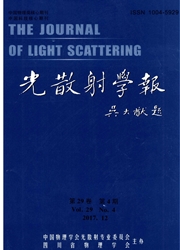

 中文摘要:
中文摘要:
腺嘌呤/金属体系中电荷转移(CT)增强机理的深人认识对理解单分子SERS和TERS中的巨大增强效应意义重大。受激发光波长的限制,关于CT是否存在的实验证据目前还未见报道。本文在获得钯上uV—SERS的基础上,借助紫外光激发的优势,研究了腺嘌呤吸附在钯包金体系中的电荷转移增强机理。通过分析三个激发光波长下(325nm、514.5nm和832.8nm)的电位SERS谱,获得了峰值电位与激发光能量hv之间斜率为正的线性关系,从实验上首次证实了腺嘌呤吸附在钯上的电荷转移增强机理,电荷转移方向是从金属到分子。这对深入认识SM—SERS或TERS中腺嘌呤在金和银上的巨大增强效应起到了一定的指导作用。
 英文摘要:
英文摘要:
Studies on the charge transfer enhancement mechanism of adenine/metal system are very important for the understanding of the huge enhancements observed in the single molecule SERS (SM-SERS) or tip-enhanced Raman spectroscopy (TERS). However, direct experimental proof has not been achieved mainly due to the limit in the excitation lines used which usually focus on visible or NIR region. Owing to the successive acquirement of UV-SERS on palladium surface, the excitation with higher energy of ultraviolet (UV) laser will bring some new insights into the understanding of SERS mechanism. In this paper, charge transfer enhancement of adenine molecules adsorbed on Pd was verified for the first time on the basis of the potential dependent SERS spectra with a UV laser (325 nm) and two visible lasers (514.5 nm and 632.8 nm) excitations. Linear relationship with a positive slope between excitation energy and Emax (potential at which intensity reaches maximum) was observed, indicating a metal to molecule charge transfer. The UV excitation displays an obvious advantage in its ability to bring a large difference of Emax from those with visible laser excitations.
 同期刊论文项目
同期刊论文项目
 同项目期刊论文
同项目期刊论文
 期刊信息
期刊信息
